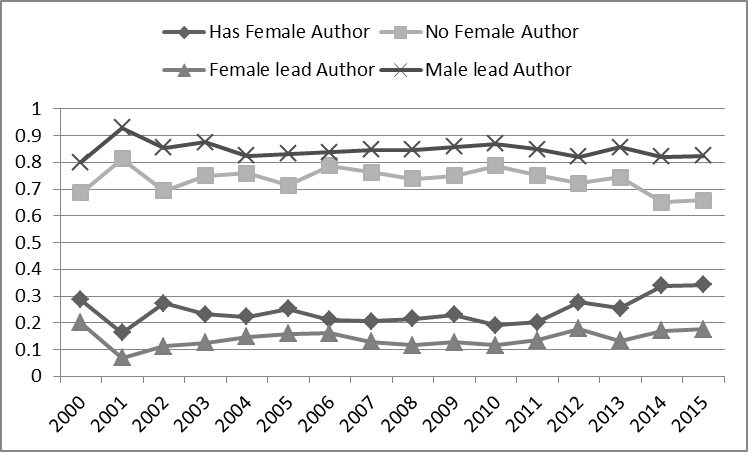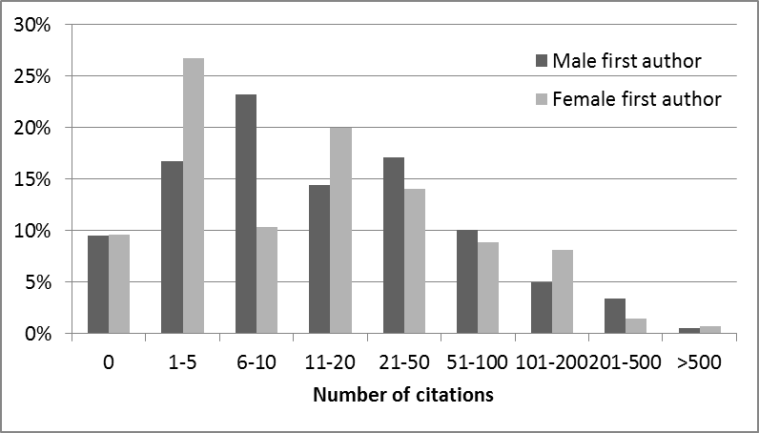A paper in ISMIR 2016 titled “WiMIR: An Informetric Study on Women Authors in ISMIR” (Hu et al., 2016) presents an informetric study of the publication, authorship and citation characteristics of female researchers in the context of the ISMIR conferences, with interesting findings that give rise to both positive and negative issues related to gender imbalance in the field. In this study, the ISMIR online proceedings and conference web pages served as the sources for collecting information of ISMIR papers and their authors. Then, the gender of each author were manually determined and labelled based on their names, relying on the collective knowledge of the authors and assistance from the ISMIR community. Regarding citation counts of the publications, Google Scholar was used as the source of citation data, which indexes a wide variety of academic sources including books, conference papers and working papers.
From 2000 to 2015, among the 1863 identified unique authors who published at least one paper in the ISMIR proceedings, 14.71% (274) were female and 85.29% (1589) were male. Among the 1610 papers published over the years, 24.2% (389) had female first co-authors and 14.1% (227) had female first authors. Meanwhile, 73.8% (1188) of all papers did not have any female authors, and 84.6% (1362) were led by male authors. The chart below shows that there is virtually no improvement over the years in terms of the proportion of papers led by female authors. However, more papers with female co-authors appeared in recent years.
Proportion of ISMIR papers by each gender (2000-2015):

In the following chart, it is shown that the most proliferate female and male researchers had led almost an equal number of papers, illustrating the pattern that the most productive women researchers performed as well as the most productive men researchers.
Number of ISMIR papers led by each gender

In terms of the institutions of female authors in the field, the top three institutions with the largest numbers of ISMIR papers led by female authors were University of Illinois, Queen Mary University of London and McGill University. The ranks of these three institutions were actually earned by their female students, since no female researchers with permanent positions in these institutions has ever led an ISMIR paper. This shows the strong contribution female students made to this field, corroborating the importance of supporting junior female researchers through mentorship programs. For the disciplines of female authors, the most popular discipline is Computer Science, followed by Library and Information Science, then Music Technology, both of which are quite interdisciplinary.
As for the distribution of geographic locations of female authors, most were from North America and Europe since most labs in the MIR field are located in these areas. Seconding these were Asia and Pacific regions. It is thus suggested that promoting international collaborations between regions with more established and reputable research facilities and those emerging but less developed regions would be a fruitful approach to cultivate female researchers in the field.
The chart below shows the co-authorship trend over the years, which shows that the average number of co-authors per paper has been increasing over the years, and this is true for papers led by either gender. Among the 214 single authored papers, 16.3% (35) were written by female authors and 83.7% (179) by males. In particular, 8.0% (22) of female authors had single-authored one or more ISMIR papers while 8.1% (129) of male authors had done so. Both female and male authors reach out for collaborations, perhaps due to the interdisciplinary nature of the MIR field, with the average number of male co-authors being higher than that of female co-authors.
Number of co-authors per paper (2000-2015)

The study also conducted a social network analysis (SNA) on the co-authorship networks of female researchers and their collaborators. In the figure below, each node represents an author and authors who often collaborated with each other were grouped into clusters. The size of a node is proportional to the number of ISMIR papers led by the author. Some clusters contain multiple female authors with a relatively high number of publications, attributable to the research groups these authors were affiliated with. It is verified that having research labs or groups is important for fostering the growth of female researchers.
Co-authorship networks of ISMIR female authors (groups with at least five female authors are presented)

With regard to citation counts, the average citation count of all papers with female researchers as the leading author is lower than that of papers with male leading authors, yet without a statistically significant difference. The difference is even smaller for citation counts of single-authored papers. It is also shown from the chart below that the distributions of papers led by male and female authors by the number of citations are very similar, ranging from the proportion of papers with no citation to that of high-cited papers. Such findings render that the scholarly impact of authors in both genders is similar. This is an encouraging result that such gender disparity in scholarly impact measured by citation counts is not significant in the MIR field.
Distribution of female and male-led ISMIR papers by number of citations.

Topic analysis was conducted with the titles of the papers, so as to identify the topics female authors tended to pursue. The results show that female researchers collaborated with male to work on key detection and evaluation, whilst female authors also worked together on user studies. Papers led by female authors were more likely to focus on melody similarity, mood classification, retrieval systems, corpus and data sources, as well as cross-cultural issues. In contrast, male researchers were most likely to write about Markov model, audio signals, audio features, and Web-based approaches. These differences in focus, according to the study, may reflect the distribution of representation of women in Computer Science and Engineering, where proportionately more women in those fields focus on Human-Computer Interaction (e.g., user studies, cross-cultural issues, digital libraries) rather than signal processing (e.g., audio signals, audio features).
Overall, the study concluded that it is discouraging to see the participation of female authors in this field has hovered throughout the history of ISMIR without much improvement over time. However, the most prolific authors of both genders are similarly productive and papers led by both genders are cited at similar rates. This study has highlighted the importance of the role of mentorship through co-authoring papers. It is also vital for female researchers to be part of research labs or groups for increasing the number of female scholars in this field, where a promising approach is promoting international collaborations that connect female researchers in less represented regions with more established groups. The study also suggests encouraging and attracting female contributors from interdisciplinary fields such as Information Science and Music Technology. These areas are also crucial for the development of usable, effective music systems that help understand users and their needs, for creating new systems that integrate with both technological and social infrastructures.
References
Hu, X., Choi, K., Lee, J. H., Laplante, A., Hao, Y., Cunningham, S. J., Downie, J. S. (2016). WiMIR: An Informetric Study on Women Authors in ISMIR. In Proceedings of the 17th International Conference on Music Information Retrieval (ISMIR).
